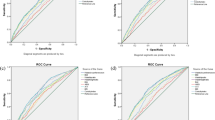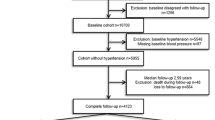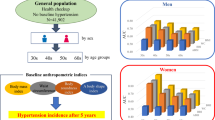Abstract
To estimate the risk and population attributable risk of prehypertension that is due to abdominal obesity in White, Black and Hispanic American adults. To determine how much of the relative difference in the risk of prehypertension between high-risk Blacks and Hispanics and the low-risk group Whites that is attributable to their differences in abdominal obesity. Data (n=4016) from the 1999 to 2000 US National Health and Nutrition Examination Surveys were used in this study. Abdominal obesity was defined as waist circumference ⩾102 and ⩾88 cm in men and women, respectively. Prehypertension was defined as not being on antihypertensive medication and having systolic blood pressure of 120–139 mmHg or diastolic blood pressure of 80–89 mmHg. Odds ratio from the logistic regression analysis was used to estimate the risk of prehypertension that was due to abdominal obesity. To estimate prehypertension risk differences between low-risk Whites and high-risk Blacks and Hispanics that was due to abdominal obesity, we estimated relative attributable risk. Statistical adjustments were made for age, blood glucose, total cholesterol, current smoking and exercise. Abdominal obesity was associated with increased odds of prehypertension in Whites, Blacks and Hispanics. In men, abdominal obesity was associated with 44, 90 and 98% increased odds of prehypertension in Whites, Blacks and Hispanics, respectively. The corresponding values in women were 112, 198 and 104%. Proportions of risk of prehypertension explained by abdominal obesity were 15.2, 22 and 25.8% in White men, Black men and Hispanic men, respectively. The corresponding values in women were 38.8, 58.6 and 32.5%. Approximately, 7% of the differences in the risk of developing prehypertension between White and Black men and between White and Hispanic men may be attributable to differences in rates of abdominal obesity. The analogous values for women were ∼39.7 and ∼16.5%, respectively. In conclusion, despite having lower rates of abdominal obesity than their counterparts, Black men, Hispanic men and Hispanic women had high population attributable risks, indicating that factors other than abdominal obesity may have important explanatory power for racial differences in prehypertension in these groups. However, in Black women reduction in risk of prehypertension could be possible by instituting public health measures to reduce abdominal obesity to the levels seen in White women. Intervention programmes designed to reduce overall obesity may also lead to reduction of abdominal obesity, and consequently may curb prehypertension in these population groups. Life-style modification, including diet and exercise, may have public health significance in reducing the incidence of prehypertension in these populations.
This is a preview of subscription content, access via your institution
Access options
Subscribe to this journal
Receive 12 digital issues and online access to articles
$119.00 per year
only $9.92 per issue
Buy this article
- Purchase on Springer Link
- Instant access to full article PDF
Prices may be subject to local taxes which are calculated during checkout
Similar content being viewed by others
References
National Institute of Health/National Heart Lungs and Blood. Clinical guidelines on the identification, evaluation, and treatment of overweight and obesity in adults. The Evidence Report. Obes Res 1998; 6: 51S–209S.
Chobanian AV et al. The Seventh Report of the Joint National Committee on prevention, detection, evaluation, and treatment of high blood pressure: the JNC 7 Report. JAMA 2003; 289: 2560–2571.
Okosun IS et al. Abdominal adiposity and clustering of multiple metabolic syndrome in White, Black and Hispanic Americans. Ann Epidemiol 2000; 10: 263–270.
Okosun IS et al. Hypertension and type 2 diabetes comorbidity in adults in the United States: risk of overall and regional adiposity. Obes Res 2001; 9: 1–9.
Watanabe J, Tochikubo O . Relationship between visceral fat accumulation and hypertension in obese men. Clin Exp Hypertens 2003; 25: 199–208.
Harris MM et al. Associations of fat distribution and obesity with hypertension in a bi-ethnic population: the ARIC study. Atherosclerosis Risk in Communities Study. Obes Res 2000; 8: 516–524.
Calle EE et al. Body-mass index and mortality in a prospective cohort of U.S. adults. N Engl J Med 1999; 341: 1097–1105.
Seidell JC, Verschuren WM, van Leer EM, Kromhout D . Overweight, underweight, and mortality. A prospective study of 48,287 men and women. Arch Intern Med 1996; 156: 958–963.
Peeters A et al. Obesity in adulthood and its consequences for life expectancy: a life-table analysis. Ann Intern Med 2003; 138: 24–32.
Haffner SM et al. Prospective analysis of the insulin-resistance syndrome (syndrome X). Diabetes 1992; 41: 715–722.
Despres J-P . Abdominal obesity as an important component of insulin-resistance syndrome. Nutrition 1993; 9: 452–459.
Ross R, Freeman J, Hudson R, Janssen I . Abdominal obesity, muscle composition, and insulin resistance in premenopausal women. J Clin Endocrinol Metab 2002; 87: 5044–5051.
Landsberg L . Obesity and the insulin resistance syndrome. Hypertens Res 1996; 19(Suppl 1): S51–S55.
Bermudez OI, Tucker KL . Total and central obesity among elderly Hispanics and the association with Type 2 diabetes. Obes Res 2001; 9: 443–451.
Ivandic A et al. Insulin resistance and androgens in healthy women with different body fat distributions. Wien Klin Wochenschr 2002; 114: 321–326.
Lean ME, Han TS, Morrison CE . Waist circumference as a measure for indicating need for weight management. BMJ 1995; 311: 158–161.
Han TS, McNeill G, Baras P, Forester MA . Waist circumference predicts intra-abdominal fat better than waist : hip ratio in women. Proc Nutr Soc 1995; 54: 152A (Abstr).
Velasquez-Melendez G et al. Evaluation of waist circumference to predict general obesity and arterial hypertension in women in Greater Metropolitan Belo Horizonte, Brazil. Cad Saude Publica 2002; 18: 765–771.
Foucan L, Hanley J, Deloumeaux J, Suissa S . Body mass index (BMI) and waist circumference (WC) as screening tools for cardiovascular risk factors in Guadeloupean women. J Clin Epidemiol 2002; 55: 990–996.
Foucan L, Hanley J, Deloumeaux J, Suissa S . Body mass index (BMI) and waist circumference (WC) as screening tools for cardiovascular risk factors in Guadeloupean women. J Clin Epidemiol 2002; 55: 990–996.
Ezzati TM et al. Sample design: Third National Health and Nutrition Examination Survey. Vital Health Stat 2 1992; 113: 1–35.
National Center for Health Statistics. National Health and Nutrition Examination Survey III: Data Collection Forms. National Center for Health Statistics: Hyattsville, MD, 1991.
Lohman TG, Roche AF, Martorell R (eds). Anthropometric Standardization Reference manual. Human Kinetics Book: Champaign, IL, 1988.
American Heart Association. Home monitoring of high blood pressure. Available at: http://www.americanheart.org/presenter.jhtml?identifier.
NHANES. http://www.cdc.gov/nchs/data/nhanes/guidelines1.pdf.
SAS Release. SAS Release 11.5. SAS Institute: Cary, NC, 2002.
Shah BV, Barnwell BG, Bieler GS . SUDAAN User's Manual. Research Triangle Institute: Research Triangle Park, NC.
Wolter KM . Introduction to Variance Estimation. Springer-Verlag: New York, NY, 1990.
Kleinbaum DG, Kupper LL, Morgenstern H . Epidemiologic Research. Principles and Quantitative Methods. Livetime Learning Pub: Belmont, CA, 1988.
Breslow NE, Day NE . Statistical Methods in Cancer Research. Analysis of a Case–Control Studies. IARC Scientific Publications #32: Lyon, 1980.
Lele C, Whittemore AS . Different disease rates in two populations: how much is due to differences in risk factors? Stat Med 1997; 16: 2543–2554.
Definitions of attributable risk—revisited. Public Health Rev 1995; 23: 343–355.
Gefeller O . Relative attributable risks. Epidemiology 1997; 7: 217–218.
Associations between weight gain and incident hypertension in a bi-ethnic cohort: the Atherosclerosis Risk in Communities Study. Int J Obes Relat Metab Disord 2002; 26: 58–64.
Deubner DC et al. Attributable risk, population attributable risk, and population attributable fraction of death associated with hypertension in a biracial population. Circulation 1975; 52: 901–908.
Landis JR, Lepkowski JM, Eklund SA, Stehouwer SA . A statistical methodology for analyzing data from a complex survey: the first National Health and Nutrition Examination Survey. Vital Health Stat 2 1982; 92: 1–52.
Acknowledgements
Data from the 1999 to 2000 were obtained from the US National Center for Health Statistics.
Author information
Authors and Affiliations
Corresponding author
Rights and permissions
About this article
Cite this article
Okosun, I., Boltri, J., Anochie, L. et al. Racial/ethnic differences in prehypertension in American adults: Population and relative attributable risks of abdominal obesity. J Hum Hypertens 18, 849–855 (2004). https://doi.org/10.1038/sj.jhh.1001771
Received:
Revised:
Accepted:
Published:
Issue Date:
DOI: https://doi.org/10.1038/sj.jhh.1001771
Keywords
This article is cited by
-
Anthropometric measures of obesity and associated cardiovascular disease risk in the Eastern Caribbean Health Outcomes Research Network (ECHORN) Cohort Study
BMC Public Health (2021)
-
Stage 1 hypertension, but not elevated blood pressure, predicts 10-year fatal and non-fatal CVD events in healthy adults: the ATTICA Study
Journal of Human Hypertension (2019)
-
Prevalence of prehypertension and associated risk factors among Chinese adults from a large-scale multi-ethnic population survey
BMC Public Health (2016)
-
A collaborative study of the etiology of breast cancer subtypes in African American women: the AMBER consortium
Cancer Causes & Control (2014)
-
Elevated serum neutrophil elastase is related to prehypertension and airflow limitation in obese women
BMC Women's Health (2011)



